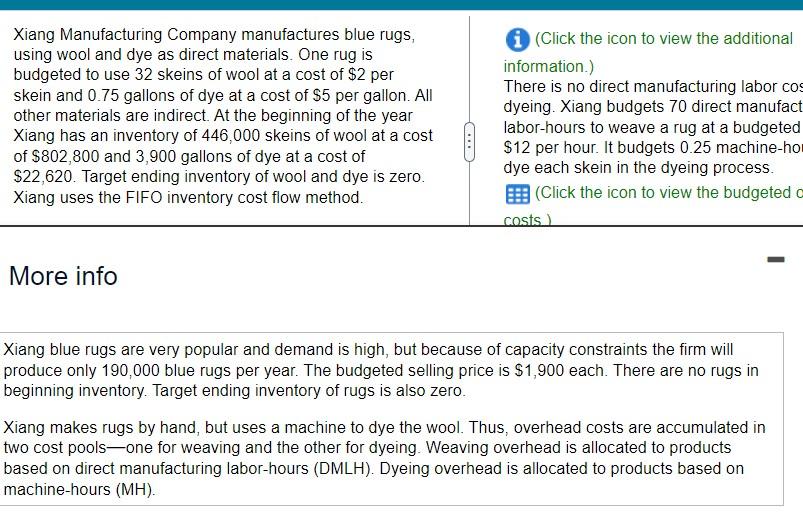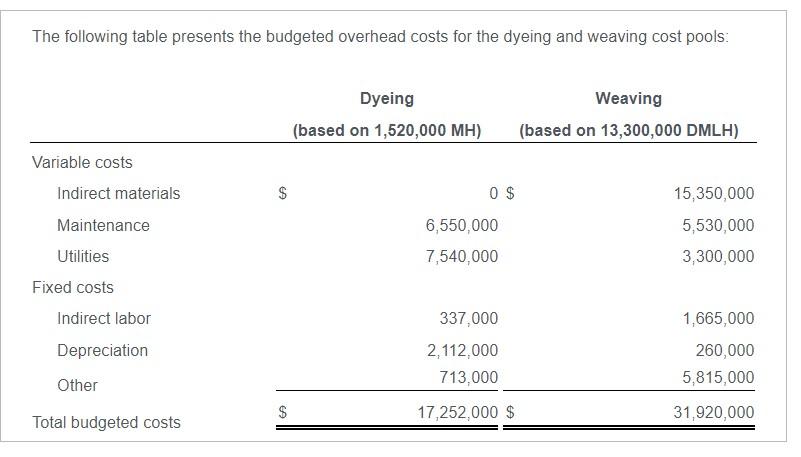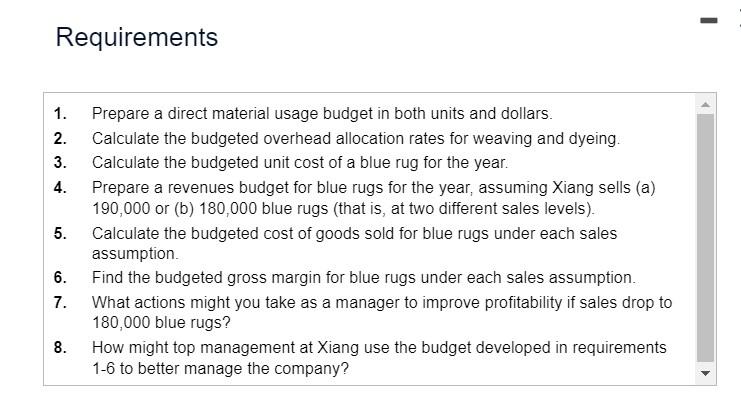Calculate the budgeted overhead allocation rates for weaving and dyeing.




More info Xiang blue rugs are very popular and demand is high, but because of capacity constraints the firm will produce only 190,000 blue rugs per year. The budgeted selling price is $1,900 each. There are no rugs in beginning inventory. Target ending inventory of rugs is also zero. Xiang makes rugs by hand, but uses a machine to dye the wool. Thus, overhead costs are accumulated in two cost pools-one for weaving and the other for dyeing. Weaving overhead is allocated to products based on direct manufacturing labor-hours (DMLH). Dyeing overhead is allocated to products based on machine-hours (MH). The following table presents the budgeted overhead costs for the dyeing and weaving cost pools: Requirements 1. Prepare a direct material usage budget in both units and dollars. 2. Calculate the budgeted overhead allocation rates for weaving and dyeing. 3. Calculate the budgeted unit cost of a blue rug for the year. 4. Prepare a revenues budget for blue rugs for the year, assuming Xiang sells (a) 190,000 or (b) 180,000 blue rugs (that is, at two different sales levels). 5. Calculate the budgeted cost of goods sold for blue rugs under each sales assumption. 6. Find the budgeted gross margin for blue rugs under each sales assumption. 7. What actions might you take as a manager to improve profitability if sales drop to 180,000 blue rugs? 8. How might top management at Xiang use the budget developed in requirements 1-6 to better manage the company? Requirement 2. Calculate the budgeted overhead allocation rates for weaving and dyeing. Begin by determining the formula, then calculate the budgeted overhead allocation rate for weaving. (Round your answer to the nearest cent.) =Budgetedmanufacturingoverheadrate= More info Xiang blue rugs are very popular and demand is high, but because of capacity constraints the firm will produce only 190,000 blue rugs per year. The budgeted selling price is $1,900 each. There are no rugs in beginning inventory. Target ending inventory of rugs is also zero. Xiang makes rugs by hand, but uses a machine to dye the wool. Thus, overhead costs are accumulated in two cost pools-one for weaving and the other for dyeing. Weaving overhead is allocated to products based on direct manufacturing labor-hours (DMLH). Dyeing overhead is allocated to products based on machine-hours (MH). The following table presents the budgeted overhead costs for the dyeing and weaving cost pools: Requirements 1. Prepare a direct material usage budget in both units and dollars. 2. Calculate the budgeted overhead allocation rates for weaving and dyeing. 3. Calculate the budgeted unit cost of a blue rug for the year. 4. Prepare a revenues budget for blue rugs for the year, assuming Xiang sells (a) 190,000 or (b) 180,000 blue rugs (that is, at two different sales levels). 5. Calculate the budgeted cost of goods sold for blue rugs under each sales assumption. 6. Find the budgeted gross margin for blue rugs under each sales assumption. 7. What actions might you take as a manager to improve profitability if sales drop to 180,000 blue rugs? 8. How might top management at Xiang use the budget developed in requirements 1-6 to better manage the company? Requirement 2. Calculate the budgeted overhead allocation rates for weaving and dyeing. Begin by determining the formula, then calculate the budgeted overhead allocation rate for weaving. (Round your answer to the nearest cent.) =Budgetedmanufacturingoverheadrate=










